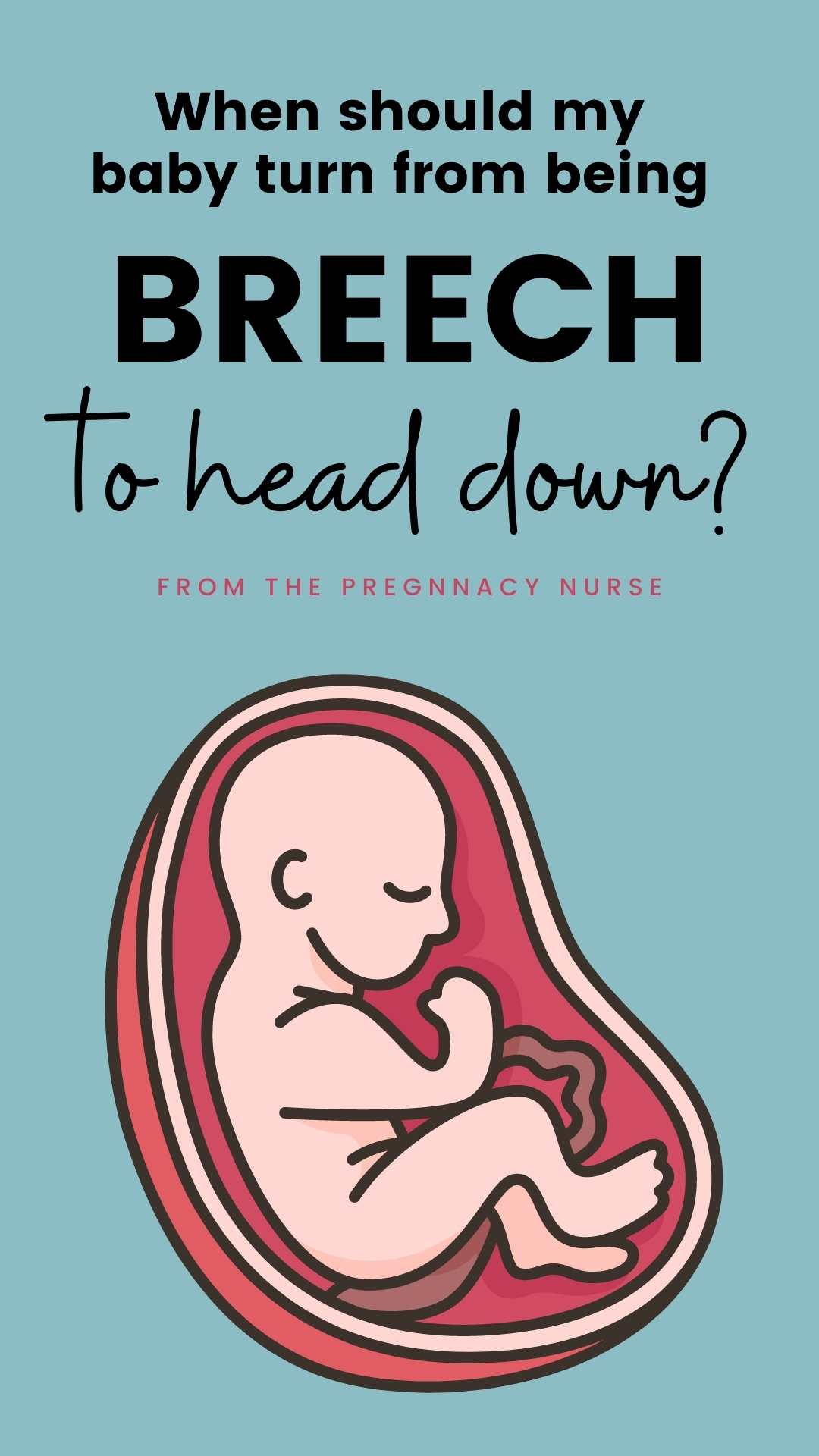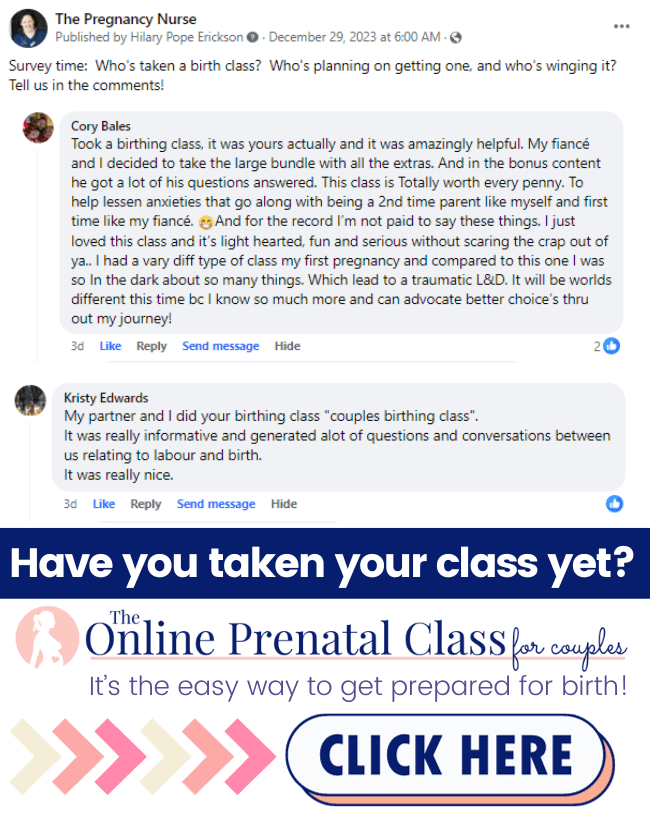👋 I’m so glad YOU are here. Are you looking to also get your partner prepared? This is for BOTH of you. Couples just love it and I know you want to both feel prepared!
Every pregnant woman wonders when their baby will turn head down. Most babies will turn head down by the end of 36 weeks, but some babies won’t turn until labor begins. There are a few things you can do to help your baby turn head down. Spending time on your hands and knees, swimming, and using an exercise ball may help your baby turn head down. This article is going to talk all about the position of the baby and what i affects as you move through your pregnancy.
But first, how do I know all of this? Hi — I’m Hilary — The Pregnancy Nurse 👩⚕️. I have been a nurse since 1997 and I have 20 years of OB nursing experience, I am also the curly head behind Pulling Curls and The Online Prenatal Class for Couples. 🩺 I have seen thousands of breech babies in my time and I have seen SO many worried moms. So, I’m a good one to help answer this question for you.
First off, I want to say that if you are before 32-34 weeks of pregnancy and baby is not head down — this is not a reason to worry. I see a lot of people concerned from the 20 week ultrasound that they have a breech baby and that isn’t an issue at all. Baby will change positions many times before “settling in” during the 1st, and second trimesters.
And of course, this is NOT medical advice, just information that you can take back to your healthcare provider to make the best plan of care for you and your baby.
What are the different positions a baby can be in during pregnancy
The different positions are all described by where baby’s head is in the womb.
There are three main positions a baby can be in during pregnancy: head down (called Vertex), breech, and transverse.
Head down (also medically called vertex or cephalic presentation) is the position most babies are in when they’re born. This is also the position that’s easiest for delivery. Baby is facing your back, with their head ready to come out first.
Breech is when baby’s bottom or feet at the bottom of the uterus near the birth canal, ready to come out first. This is not the ideal position for delivery, and often leads to a cesarean section. There are a few different positions for breech babies:
- Frank breech — where baby’s legs are straight up in the air
- Footling breech — where one foot is coming out of the cervix (obviously only happens once your water breaks)
- Complete breech — where baby’s legs are tucked up under them
Transverse is when baby is lying sideways across your uterus. This position makes vaginal delivery very difficult, and often leads to a cesarean section (but baby often slides into place as they grow larger).
There are other positions of the baby’s head & face (if they are facing up or down, or somewhere in the middle) but those aren’t as important to talk about ahead of labor — and they won’t affect you having a vaginal birth. However, baby’s position IS important in your labor process beyond just ‘head down”
Pro Tip: If baby is facing upwards some providers call that “sunnyside up” but the actual name is occiput posterior (or posterior position) — meaning the head is facing the back. Most providers call it OP for short. While this can prevent baby from flexing their neck in the best way for birth, most babies turn at some point during labor to not be OP.
Quickly, I want to remind you that ALL of labor can be unpredictable. This is why I strongly encourage you to get prepared for lots of scenarios with a great prenatal class like this one.
How do you know if your baby is head down
If you’re wondering what baby’s position is, there are a few things you can look for.
Of course, the most accurate way is an ultrasound scan (I even have a post on at-home ultrasound machines). But, we know those are not always available. However, on every ultrasound they do note the fetal position.
There are a few ways to check at home.
First, feel around your belly for where the hard part of baby’s head is. This is called the occiput, and it’s at the back of baby’s head. You should be able to feel it at the top of your uterus. If you can’t find the occiput, it’s likely that baby’s head is down. However, many bellies can feel hard no matter what, so this isn’t foolproof.
Another way to tell if baby is head down is to look at your belly. If it’s round and high, like a basketball, then baby is more likely to be head down. If your belly is long and low, like a watermelon, then baby is more likely to be breech. But again, this is hard to tell if you haven’t seen a LOT of bellies.
You can also ask your health care provider to check baby’s position during a prenatal visit. They’ll feel around your belly (similar to what you’d do at home, but with more experience) and see where baby’s heartbeat is at. Baby’s heartbeat will normally be higher up if their head is down (although plenty of head-down babies have surprised me when the heart was awfully high).
They can also check baby’s position when they do a cervical exam (if your cervix is open). The provider normally touches the baby’s head when they check you (or at least tries to). I have a whole post on how to tell if baby is head down that you might find helpful.
What are the benefits of having a baby in the head down position
The main benefit is that your doctor will be willing to do a vaginal delivery.
In the US most providers will not attempt a breech delivery. I have heard their malpractice insurance can get upset if they do them. ACOG recommends that they do breech births via cesarean delivery unless they have a lot of experience in breech vaginal deliveries. They also recommend they try a version before doing a cesarean.
What is a Version?
The full name is a external cephalic version — also known as ECV. This is when the doctor uses their arms to manipulate baby into a head-down position.
These can be extra successful if baby is in a transverse lie (lie is another word for position).
Some doctors are more skilled at versions than others (I have seen this a lot in my time as a nurse) and may have a high success rate.
They will lubricate your belly with a lot of jelly, then they will use their hands and forearms to position baby as another practitioner holds the ultrasound machine to see if baby moves. We will also be monitoring baby’s heart rate as we do this to make sure that they are OK as the version happens.
Does a version hurt?
Most women complain about a LOT of pressure. I would recommend doing some relaxing techniques before going in for a version.
They say that doctors use “light pressure” but it doesn’t seem like that to someone assisting them. It is a very firm pressure and can last a few minutes. Obviously, it’s not HARD but it’s FIRM.
What if my baby doesn’t turn with a version?
I think is really important to remember that your womb has some complicated areas. Perhaps the placenta or cord is preventing baby from turning. We don’t want to push baby into a position that is unsafe (and sometimes, even if we do — baby turns right back to the way they were). Be prepared to do the safest thing in an area that you’re not sure of all the complications that might be happening.
Who knows if it is unsafe, or if baby has just found a comfortable position and keeps returning to it. Either way, if your baby won’t move (or stay moved) it can be an issue.
I have a whole post about my favorite ways to get baby to turn head down you might find helpful.
Can I have a vaginal breech birth?
You can do whatever you want with your birth. However, your provider may say that they will NOT plan a vaginal breech birth. As it is against their ACOG recommendations, if something goes wrong they could lose their license and not be able to practice anymore.
If you are interested in a vaginal breech birth tell your provider and see what they say. Be prepared for them to push back a LOT (because they can be risky — especially since most providers anymore are not experienced in doing them), but they may have some ideas of someone else you could go to for that.
The main issue is that the baby’s head could get stuck inside. As babies are not formed to come out in a breech presentation this could be a big problem (if it is a problem). Honestly, I think I have only seen 4-5 breech deliveries in my 20 years. All happened when the patient came in with either the baby coming out breech or the second twin after the first came out vaginally without issue.
Again, they can’t force you into a cesarean at any point, but it will be their recommendation, and they could discharge you from their practice if you won’t schedule a cesarean section.
When does a baby usually turn head down
Most babies will turn head down by the end of 36 weeks. However, some babies don’t turn until labor begins. If your baby is breech or transverse at 36 weeks, your doctor may recommend a Version (ECV) to help them turn. ECV is a safe and effective way to turn a baby, but it doesn’t always work. If ECV is unsuccessful, you may need to have a cesarean section.
As you enter your third trimester you’re going to want to see where baby is position, just so you know — and monitor it as your pregnancy progresses. Remember, a breech presentation at 28 weeks is still VERY likely to turn (mother nature somehow tells most babies to turn) as you head towards the end of pregnancy.
What are some things you can do to encourage your baby to stay in the head down position
There are a few things you can do to encourage your baby to stay in the head down position (or change get into the optimal position), but many are “old wive’s tales”
Some think that laying on your back can cause baby to be breech. However, it is more likely to restrict blood flow to baby.
Many believe that upright positions are better for baby — positions like sitting, standing, and walking. These positions help baby get into the head down position. I have also heard that circling on a yoga ball can help baby turn as it may open up the pelvis for baby to turn. and drop down.
And some believe that sleeping on your side will help baby turn. Honestly, I don’t think your sleeping position has too much to do with it (although most women find that sleeping on their side with a pillow under their belly and one between their knees to be the most comfortable).
What can I do to get baby to turn vertex?
I recommend spinning babies — they have a lot of great positions you can try to get baby to move. Frankly, they have great information for baby’s position in the womb in general (and baby’s position has a lot to do with how labor progresses).
I have also seen a LOT of patients have good luck seeing a chiropractor. They somehow manipulate your pelvis in ways that helps baby turn into the best position as they get close to birth. if you are past 30 weeks, and baby turns breech a chiropractic visit might not be a bad idea (many insurances cover it).
I did a podcast with a favorite chiropractor that you can listen to here:
They can also help a lot of hip and pelvis pain, so that is a win either way!
**Pro tip: be sure to find a chiropractor trained in the Webster technique as this is methods they use to help open up your pelvis.
What are the risks associated with a baby being in the breech position
The main one is needing a cesarean section. There is no big risk to the baby living in a breech position.
Although, there is a position called “frank breech” in which the legs are straight up. Every now and then that can cause some hips issues, but most aren’t problematic. Also, baby may have their legs up like that for a few days after birth until their hips relax.
What are the risks associated with a baby being in the transverse position
Again, the main issue is the possibility that baby will need to be born cesarean section.
While it is easier, and more normal for a transverse baby to be able to be manipulated into a vertex presentation (with head down) if a transverse baby will not turn it is almost impossible to birth them. Birth can not start with a hand or just one foot — birth can truly not be done that way.
With twins we often have one that is transverse. Most often they turn after the first twin is born, but every now and then they won’t turn and we only get one foot or a hand that will come out — and in those cases we have to do a cesarean section.
And yes, this type of information only comes from people with lots of experience. Which is why you need a prenatal class with someone who has that type of experience.
If my baby is breech, when should I worry
If you are previous to 30 weeks and baby is breech do not give this a second though. As you continue towards you due date or once you pass about 34 weeks I might be concerned. The further you get into your pregnancy, the less likely it is that baby will turn as the womb will start to feel tighter as they grow.
Using spinning babies or visiting a chiropractor can have a lot of benefits as you head into the end of your pregnancy, breech or not — so trying those things can be a win-win.
Personally, if I wasn’t already visiting a chiropractor, if I got to 30 weeks and baby wasn’t head down, I would probably schedule to see one. Mostly because there are a LOT of benefits besides turning the baby.

How can I tell if my baby has turned head down
If you’re past 36’ish weeks most women feel a HUGE movement if baby turns. Many describe it like a wave washing over them.
As I said before you can see if your belly looks different, if it feels more soft on top or if you’re feeling more kicks up top than you were before.
But, an ultrasound is the best indicator that baby is head down.
Can baby switch position after 36 weeks?
ABSOLUTELY! Of course, that means that people who have had baby head down for weeks may come in labor with baby being breech. It doesn’t happen often, but babies are tricky and we have to be prepared for whatever they’re going to do.
It is just more rare that baby turn that much after 36 weeks — but it definitely happens. I have a whole post on the symptoms of baby turning head down.
And like I said — labor is unpredictable, so make SURE to take a class that prepares you for ALL of it. The Online Prenatal Class for Couples is taught by one of the most experienced labor nurses online and covers everything you’ll need to know from bump to basinette, starting at just $35. Horray! Use coupon code PREGNURSE to save 10% on it!
Want to do a vibe check before diving into the whole thing with me? — check out my free labor pro tips. It’s your first step toward getting in the driver’s seat of your birth.








 5 Ways to Prevent Postpartum Hemorrhage
5 Ways to Prevent Postpartum Hemorrhage
